
Manufacturing high-quality cable in the US midwest
By Interpower Corporation
Electronics Supply Chain cable Manufacturing power cord wire
Sponsored by Interpower Corp.
Pardon the extrusion - lnterpower American-made cable has you wired
Whether the summer heat index climbs to 120°F, or winter windchills descend to -120°, electrical cable extrudes, coils, and bathes inside lnterpower’s manufacturing facility in Lamoni, Iowa. There, as is common to wire cablers, the intricate process of cabling spools into three separate operations: insulating, cabling, and jacketing wire.
During the insulating phase, plastic is extruded over the stranded copper wire at speeds up to 1,000 feet per minute. Quality checks at stages along the extrusion process ensure cable specifications are met-from North America to Europe, Asia, and the Middle East, meeting country-specific standards are key to growing global markets.
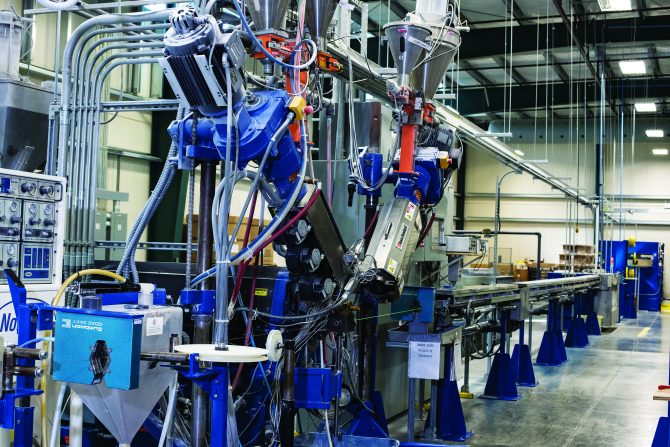
The cable extrusion process. Source: Interpower
Once the cable is extruded, its dimensions are measured, then remeasured after the cable has cooled. The insulated wire is spark-tested to ensure one hundred percent coverage over the copper. The wire is now ready to be placed on a reel for processing at the cabler.
The cabler unspools separate reels of insulated wire and twists them together into one strand of conductors, such as three-wire cabling: line, neutral, and ground wires. This is a Class I configuration, but also common is Class II, which consists of two lines without a ground plus additional insulation.
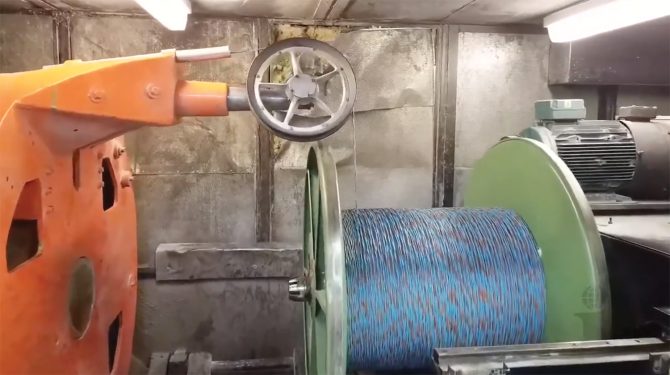
The cabler unspools separate reels of insulated wire and twists them together into one strand of conductors.
North American three-conductor cable is available in two sets of conductor colours: black (line), white (neutral), and green (ground); and brown (line), blue (neutral), and green-yellow (ground). International three-conductor cable is brown (line), blue (neutral), and green-yellow (ground). Japanese conductor colours are black (line), white (neutral), and green (ground).
“Length of lay” in cabling is the lay length of one wire strand making one full revolution around the diameter of the conductor. Why is lay length important? The nontechnical answer is flexibility-it makes the cable flexible enough to be reeled for jacketing. The jacketing process is similar to the process of insulating copper wires on the extrusion line. However, one difference is jacketing uses more extruded plastic, making it more time-consuming than insulating. Prior to extrusion, talc is applied to the twisted, insulated conductors which acts as a release-agent for stripping the jacket. This is especially user-friendly when a few millimeters of jacket need to be stripped for crimping wires.
After the jacketed products exit the extruder, they chute into a chilled water bath for the next 40 feet. Once the jacket dries, it is marked with the correct size, approvals, and lot codes. The jacketing process is continually monitored to ensure it meets specifications and standards for the countries of origin.
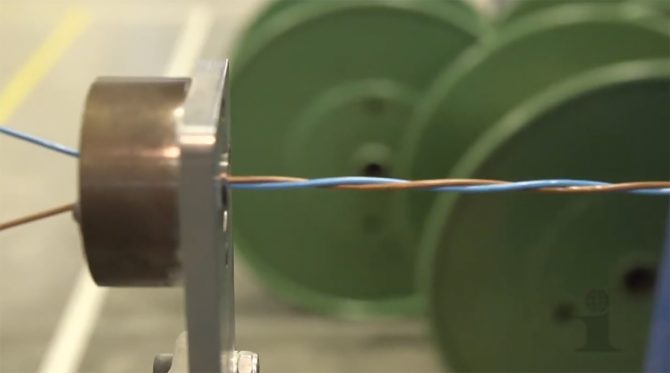
Photo illustrates cabling twisting two conductors together. Source: Interpower
Selecting the correct cable
When designing electrical products for worldwide markets, determining the correct type of cable is critical: where is the cable going? If the market is North America, then North American approved cable needs to be used.
If in Germany, then international-approved cable must be used. If China, the cable must meet Chinese standards requiring approvals from a Chinese agency-the market where products will be sold (North America, Europe, Asia, or South America) determines the type of cable and agency approvals needed. Typically countries have their own agencies: the United States (UL), Canada (CSA), and Germany (VDE), to name a few.
In What Environment Will the Cable be Used?
One main factor in determining the type of cable needed is the immediate environment. A household appliance requires a different jacket than a jacket used for industrial use. If used outdoors, one must consider abrasion, heat, and humidity-and there’s no need to rush out and reinvent plastic. UL’s iQ site offers many resin “recipes” already approved, saving manufacturers the cost of sending samples for agency testing.
North American Cable
North American cable is sized in American Wire Gauge (AWG), which uses as inverse relationship to size the larger the number the smaller the cable. Cable for single-phase applications will be either a 2- or a 3- wire variety. A 2-wire cable is for Class II (ungrounded) applications while 3-wire cable is for Class I applications, which require a ground. Three-phase applications require either a 4- or 5-wire cable.
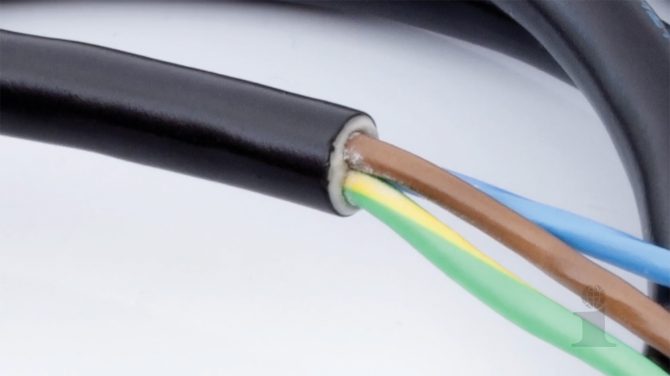
Photo demonstrates talc-coating inside the cable. Source: Interpower
Basic Cabling Material
Thermoplastic
Thermoplastic can be softened through heating and hardened through cooling. It can be molded when heated and can retain its shape after it cools. Thermoplastic is the opposite of thermoset.
Thermoplastic Elastomer
Thermoplastic or TPE is a material that has characteristics of rubber as well as thermoplastic.
Thermoset
Thermoset uses a heating process-curing-and once the plastic is cured, it can’t be altered from its original state.
PVC
PVC is a common thermoplastic material for cable and conductor jackets and some molded plugs.
Rubber
Rubber is also a common material for cable. It is a thermoset-type material. While it may be more costly than thermoplastic cable, rubber is extremely durable. Rubber is a good choice for outdoor applications.
North American Cable
There are a variety of North American cable types with letter designations indicating the product’s multiple attributes.
PVC Cable
- SJT-Junior hard service, thermoplastic-insulated conductors and
- SJTO-Same as SJT, but oil-resistant thermoplastic outer
- SJTOW-Same as SJTO except weather-resistant
- SJTW-Durable thermoplastic or rubber-insulated conductors and overall thermoplastic jacket; weather-resistant for outdoor
- SVT-Thermoplastic-insulated vacuum cleaner cord with or without a third conductor for grounding
- SPT-2-Parallel jacketed thermoplastic cable with heavier construction than SPT-
- ST-Hard service cord with all thermoplastic
- STO-Same as ST, but with oil-resistant thermoplastic outer
- STOW-Same as STO, but weather-resistant
- Thermoset Cable
- SO-Extra hard service cord, thermoset-insulated conductors and thermoset oil-resistant
- SOW-Same as SO except weather-resistant
- SOOW-Same as SO except both conductor insulation and jacket are oil-resistant and weather-resistant
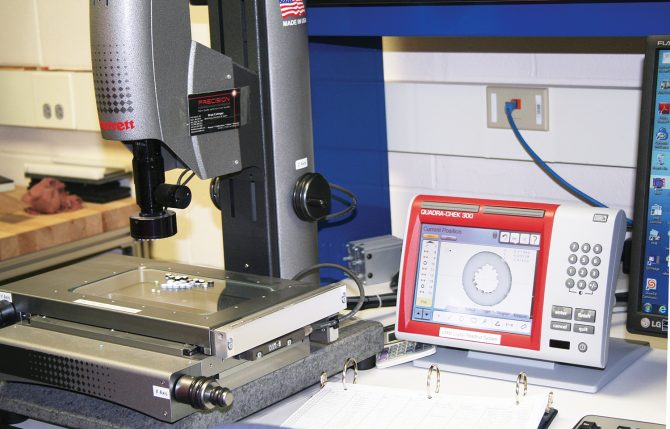
Measuring insulation jacket thickness as well as diameters. Source: Interpower
TPE Cable
- SEOW-Extra hard service cord, thermoplastic elastomer conductor insulation and jacket with oil resistant jacket and weather-resistant
- SJEOW-Hard service cord, thermoplastic elastomer insulation and jacket and weather-resistant
International Cable
A series of numbers and letters indicate the jacket material, ratings, and size of the cable. The types of international cable offered by lnterpower include:
- H03VV-F
- HOSV-K
- HOSRN-F
- HOSVV-F
- H07V-K
- H07RN-F
- RVV
- VCTF
- HVCTF
- SOSVC4VF
Cable diameter tracking is completed during the extrusion process. Source: Interpower
Cabling & Content
Cabling and other electrical processes hold prominent space inside lnterpower’s content pages where myriad electrical products, ratings, and standards are available in a few clicks. With a library of videos and written electrical content from industry leaders such as lnterpower CEO Bob Wersen, and product development, quality assurance, and customer support specialists such as Ron Barnett, Joe Caliguri, and Dan Ford respectively, lnterpower offers industry peers timely information on ever-changing standards, directives, requirements, and approvals from UL, CSA, IEC, VOE, and many other global agencies and committees.
The content provides comprehensive insights from how to export country-specific electrical cord sets and components to calculating cord length or voltage drop. It highlights how different manufacturing processes work such as cabling and ultrasonic welding, and the rigorous testing procedures per given myriad agency standards.
———————
Icons represent cable use. Source: Interpower
For more information and other electrical manufacturing processes, visit lnterpower at www.interpower.com
